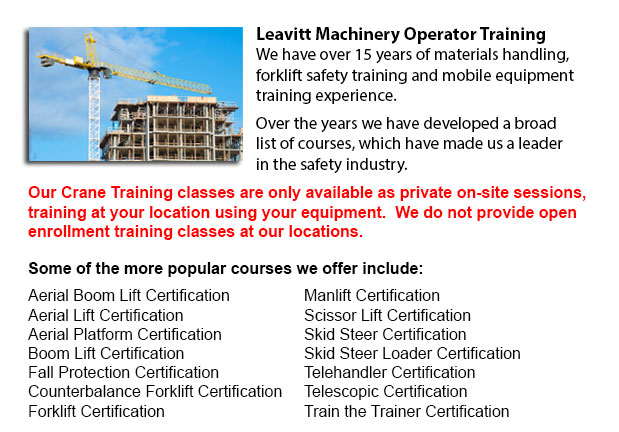
Crane Certification Markham - The Crane Certification training program consists of subject matter recommended by industry concerning the efficient and safe operation of cranes. People training would learn the following: pre-operational, operational and post operating requirements; how to identify cranes and their component parts; rigging components and inspection/rejection criteria; how to determine overall lift capacity; and needs particular to the work site where the people training will be operating.
The requirements which have to be done before operating a crane includes assigning authority for the pre-operational check; carrying out the sequential pre-operational check based on the specifications certified by a professional engineer or manufacturer's specifications; inspecting the work place for obstacles and hazards; checking the log book for comments; inspecting cables, hooks, chains safety latches and crane movement; ensuring the proper functioning of operational controls; and knowing how to make sure that the crane's disconnect switch/isolator is properly working.
Operational requirements comprise identifying responsibilities and roles, and determining the requirement for a formal lift plan. People training would learn how to carry out a hazard assessment related to environmental situations, physical conditions and workers. Subject matter comprises determining when to seek competent help, the safest route and destination of loads, and load weight and centre of gravity.
Individuals training should be able to identify an over-capacity lift, in addition to be able to choose right rigging machinery, select load limits, and to determine the safe spot for the crane to work from. Trainees would review both universal and site-specific crane signals for lifts, and methods for lifting, loading and traveling. Right maintenance practice will be included.
The person training will undergo an examination to test their knowledge of emergency response techniques for various circumstances, specially mechanical or electrical failures. They would be asked to describe shut down and parking procedures for security and safety, to follow lock out and tagging procedures, and to explain why near misses are reported and recorded to the right individual. Log book records need to be maintained.
The trainee will be taught the particulars of rigging, and be taught the responsibility and authority for rigging. They would be taught to identify the different kinds of rigging, the load capacity ratings and storage procedures.
Post-operational requirements consist of entering deficiencies or defects, maintenance and service history within the log book, based on Federal, state and provincial codes requirements.
Site-specific needs could be incorporated into the safety training program based on the employer's needs.
-
Crane / Overhead Crane / Self-Erect Crane / Truck Mounted Crane / Hydraulic Cranes Training in Markham
Bridge cranes or overhead cranes are a kind of industrial material handling crane making use of a hook and line apparatus that runs on a horizontal beam running along two widely separated rails. Many overhead cranes could be seen inside a long factor... More -
Manlift Ticket Markham
Manlift Ticket Markham - The Manlifts and Elevated Platforms program provides training on the regulations, rules and correct application of safe operating procedures and work practices involved in everyday activities for individuals who work with thi... More -
Aerial Lift Train the Trainer Markham
Aerial Lift Train the Trainer Markham - The Aerial Lifts Train the Trainer Certification Program will teach trainers how to effectively train operators in safe industrial mobile equipment operation. Trainers are given in-depth instruction on aerial l... More -
Loader Operator Training Markham
Loader Operator Training Markham - Loader Operator Training - Within North America, lift truck operator training is required to be able to prevent workplace injuries and accidents. Certain forklift training would be provided to be able to offer forkl... More -
Aerial Boom Lift Ticket Markham
Aerial Boom Lift Ticket Markham - Aerial lift trucks can be used to accomplish many unique duties done in hard to reach aerial spaces. A few of the duties associated with this style of jack include performing daily repair on buildings with high ceili... More -
Boom Lift Operator Training Markham
Boom Lift Operator Training Markham - The cherry picker work platform is a type of work platform, that will usually have a bucket or platform at the hydraulic lifting system's end. The machine is likewise called a boom lift, man lift, hydraladder or... More -
Boom Lift License Markham
Boom Lift License Markham - Just fully qualified individuals must operate an aerial boom lift. Qualification can be obtained through a combination of classroom sessions and practical training with the particular kind of aerial lift that will be used... More -
Telehandler Training Courses Markham
Telehandler Training Courses Markham - The employer has the responsibility to make certain that their workers are trained to work proficiently with telehandler machines. The staff have to be assessed for their skill to utilize the equipment. If defic... More

Forklift Training Markham
TOLL FREE: 1-888-254-6157
Markham, Ontario
forklifttrainingmarkham.com
Email Us
About Us


